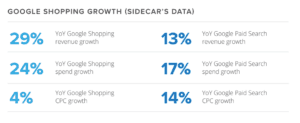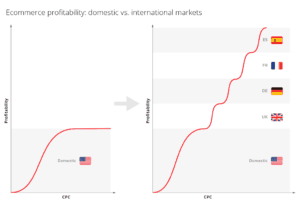
Karolina Kulach, content marketing manager, Webinterpret
Few business growth strategies could potentially multiply the size of an ecommerce business. Using Google Shopping, to reach a wider global audience may be one of them. Google Shopping shows consumers images and prices of various products next to each other allowing easy comparison.
It can be especially valuable for retailers generating satisfactory sales domestically, but facing saturation and growing competition at home. If a retailer has reached a plateau in its home market, it can increase its market size and achieve lower acquisition costs, e.g. cost-per-click, by targeting new markets.
The international markets that are particularly attractive are those characterized by a limited availability of specific products or unmet demand for unique products from overseas. Many retailers may find their products are in high demand in places they haven’t considered selling before.
For example, Italy shows a lack of dynamism in the local offering. As domestic brands tend to struggle to keep up with the pace of demand, many products have to be imported from abroad, e.g. clothes from foreign brands or vehicle parts for cars.
Another benefit for sellers expanding beyond their home markets is all-year-round sales of seasonal products. For instance, if merchants offer bathing suits and it’s downtime in winter in the Northern Hemisphere, countries in the Southern Hemisphere, such as Australia, can help keep sales of bathing suits up and running in the low cold season at home.
International sellers can also profit from more trading hours. For example, when American buyers fall asleep, Europeans may just start browsing for products. Selling internationally truly unlocks the “365 days per year, 24/7” potential.
What’s driving the growth in Google Shopping?
Advertisers are increasing their spend on Google Shopping ads faster than on Google paid search and text ads (24% vs 17%). Perhaps that’s because the conversion rate for the image-based Google Shopping ads is around 30% higher conversion rates than for text ads. An important driver for Google Shopping is mobile. It accounts for a large share of clicks and conversions in search and shopping, roughly 60-70%.
 Further, new rich formats such as Showcase Shopping ads, which allow advertisers to display an array of images of related products, are gaining momentum. They saw increased activity in 2018, generating its highest percentage of total mobile Google Shopping clicks (4.67% in October).
Further, new rich formats such as Showcase Shopping ads, which allow advertisers to display an array of images of related products, are gaining momentum. They saw increased activity in 2018, generating its highest percentage of total mobile Google Shopping clicks (4.67% in October).
Finally, cross-border sales can soon become a major driver on Google Shopping. Over 90% of the retailers we’ve surveyed declared their willingness to invest in international Shopping campaigns. By selling beyond their domestic markets, merchants can reach wider audiences. This is actually where the real sales opportunity starts, especially if local markets are competitive, like those in the USA or the UK.
Lowering the acquisition cost internationally
On Google Shopping retailers can sell on less competitive foreign markets with high sales potential. These might be markets where local online sellers aren’t able to offer specific products or meet the local demand.
The possibility of satisfying the unmet demand for unique products from overseas is one of the biggest worldwide opportunities for ecommerce retailers. This is how conversion rates can go up and CPC (cost-per-click) can go down due to a lower level of competition.
For example, comparing CPCs in the USA, Europe, and Canada, the average CPC in Europe in some product categories can be 5 to 7 times lower than in the USA. This implies lower acquisition costs and much higher profitability in certain European markets.

How to launch international Google Shopping Campaigns
Above all, the submitted product information must be clear and understandable for the target audience. Providing the correct information is important, as Google performs regular reviews to see if the information provides matches what’s on the retailer’s website. It’s necessary to check product feed specs, shopping policies and other requirements, including language and currency.
When advertising to international shoppers, the retailer’s product feeds and website should first be translated and localized. This includes product descriptions, titles, attributes, currencies, checkout flow and so on.
Second, to get Shopping ads running in other countries, tax and shipping prices must be defined and delivery information submitted. Inaccurate shipping costs can result in a warning in Google Merchant Center.
Third, product export restrictions are important, as selling some products is prohibited, such as fighting knives or throwing axes. Further, stores offering certain merchandise domestically through Google Shopping, e.g. fur or skins of certain reptiles, may not be able to sell those products in other countries.
Finally, over time retailers might conclude that their best-selling products differ per country, which may depend on product export restrictions, shipping reality, and local purchase behaviors. What can be legally or easily delivered in some countries may not be in others. Some products may be popular in one country, but the demand in another country may be insignificant.
How to maximize sales conversion
As English is the world’s most spoken language, it may seem like the optimal choice when advertising products internationally. But Google policies require merchants to submit feeds in the local buyer’s language and provide a fully localized buyer experience.
Moreover, the reality is that in international ecommerce, English is often not the language of preference when it’s not the shopper’s native language.
According to research carried out by Eurobarometer, the European Commission’s polling organization, 42% of the respondents have never purchased in a foreign language. 56.2% of consumers say that obtaining information in their own language is more important than the price. Further, based on Common Sense Advisory’s data, buyers spend over 72% of their web browsing time on local-language sites.
Additionally, buyers prefer to see prices in their own currency, without having to use a currency converter. 33% are likely to abandon a purchase if pricing is listed in US dollars only and over 90% prefer to shop and purchase in their local currency, according to Penton Research.
As a result, in most markets, you’ll have to create a localized Google Shopping product feed with a full translation of all your product catalogs and accurate currency conversion of your product prices.
To sum up the benefits of Google Shopping in international ecommerce
Going global and reaching new customers via Google Shopping offers the potential to significantly grow sales for many retailers and brands.
Sales opportunities are much bigger when you offer products in multiple countries. The reality is that there are probably (tens of) thousands of international buyers interested in
your product.
That international sales potential, combined with automated ecommerce solutions, make it worthwhile, cost-efficient and simple to sell internationally. In fact, there has never been a better time than the present to sell online abroad.
Translating and localizing product feeds and your website are fundamentally important to get the best results. This way you can provide a frictionless international shopping experience to see much higher conversions.
Webinterpret provides translation and localization services for online retailers in over 60 countries. The company has offices in France, Poland, the United Kingdom and the United States.
Favorite
